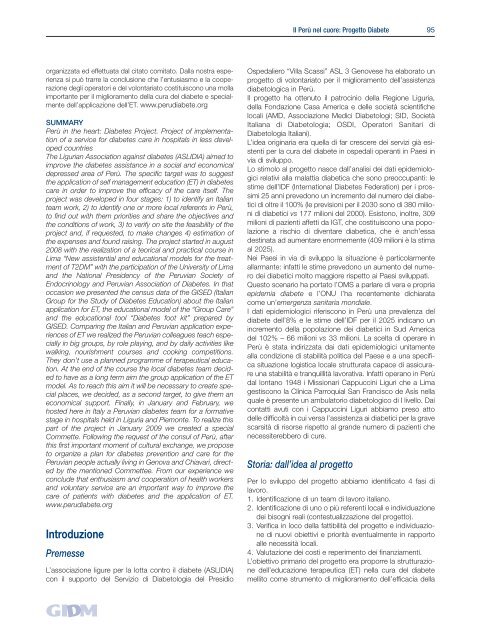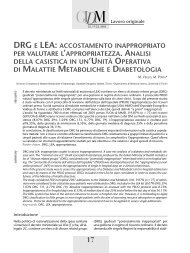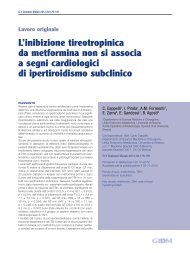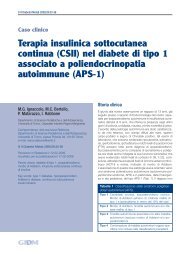articolo completo in pdf - Giornale Italiano di Diabetologia e ...
articolo completo in pdf - Giornale Italiano di Diabetologia e ...
articolo completo in pdf - Giornale Italiano di Diabetologia e ...
You also want an ePaper? Increase the reach of your titles
YUMPU automatically turns print PDFs into web optimized ePapers that Google loves.
Il Perù nel cuore: Progetto Diabete<br />
95<br />
organizzata ed effettuata dal citato comitato. Dalla nostra esperienza<br />
si può trarre la conclusione che l’entusiasmo e la cooperazione<br />
degli operatori e del volontariato costituiscono una molla<br />
importante per il miglioramento della cura del <strong>di</strong>abete e specialmente<br />
dell’applicazione dell’ET. www.peru<strong>di</strong>abete.org<br />
SUMMARY<br />
Perù <strong>in</strong> the heart: Diabetes Project. Project of implementation<br />
of a service for <strong>di</strong>abetes care <strong>in</strong> hospitals <strong>in</strong> less developed<br />
countries<br />
The Ligurian Association aga<strong>in</strong>st <strong>di</strong>abetes (ASLIDIA) aimed to<br />
improve the <strong>di</strong>abetes assistance <strong>in</strong> a social and economical<br />
depressed area of Perù. The specific target was to suggest<br />
the application of self management education (ET) <strong>in</strong> <strong>di</strong>abetes<br />
care <strong>in</strong> order to improve the efficacy of the care itself. The<br />
project was developed <strong>in</strong> four stages: 1) to identify an Italian<br />
team work, 2) to identify one or more local referents <strong>in</strong> Perù,<br />
to f<strong>in</strong>d out with them priorities and share the objectives and<br />
the con<strong>di</strong>tions of work, 3) to verify on site the feasibility of the<br />
project and, if requested, to make changes 4) estimation of<br />
the expenses and found rais<strong>in</strong>g. The project started <strong>in</strong> august<br />
2008 with the realization of a teorical and practical course <strong>in</strong><br />
Lima “New assistential and educational models for the treatment<br />
of T2DM” with the participation of the University of Lima<br />
and the National Presidency of the Peruvian Society of<br />
Endocr<strong>in</strong>ology and Peruvian Association of Diabetes. In that<br />
occasion we presented the census data of the GISED (Italian<br />
Group for the Study of Diabetes Education) about the Italian<br />
application for ET, the educational model of the “Group Care”<br />
and the educational tool “Diabetes foot kit” prepared by<br />
GISED. Compar<strong>in</strong>g the Italian and Peruvian application experiences<br />
of ET we realized the Peruvian colleagues teach especially<br />
<strong>in</strong> big groups, by role play<strong>in</strong>g, and by daily activities like<br />
walk<strong>in</strong>g, nourishment courses and cook<strong>in</strong>g competitions.<br />
They don’t use a planned programme of terapeutical education.<br />
At the end of the course the local <strong>di</strong>abetes team decided<br />
to have as a long term aim the group application of the ET<br />
model. As to reach this aim it will be necessary to create special<br />
places, we decided, as a second target, to give them an<br />
economical support. F<strong>in</strong>ally, <strong>in</strong> January and February, we<br />
hosted here <strong>in</strong> Italy a Peruvian <strong>di</strong>abetes team for a formative<br />
stage <strong>in</strong> hospitals held <strong>in</strong> Liguria and Piemonte. To realize this<br />
part of the project <strong>in</strong> January 2009 we created a special<br />
Commette. Follow<strong>in</strong>g the request of the consul of Perù, after<br />
this first important moment of cultural exchange, we propose<br />
to organize a plan for <strong>di</strong>abetes prevention and care for the<br />
Peruvian people actually liv<strong>in</strong>g <strong>in</strong> Genova and Chiavari, <strong>di</strong>rected<br />
by the mentioned Commettee. From our experience we<br />
conclude that enthusiasm and cooperation of health workers<br />
and voluntary service are an important way to improve the<br />
care of patients with <strong>di</strong>abetes and the application of ET.<br />
www.peru<strong>di</strong>abete.org<br />
Introduzione<br />
Premesse<br />
L’associazione ligure per la lotta contro il <strong>di</strong>abete (ASLIDIA)<br />
con il supporto del Servizio <strong>di</strong> <strong>Diabetologia</strong> del Presi<strong>di</strong>o<br />
Ospedaliero “Villa Scassi” ASL 3 Genovese ha elaborato un<br />
progetto <strong>di</strong> volontariato per il miglioramento dell’assistenza<br />
<strong>di</strong>abetologica <strong>in</strong> Perù.<br />
Il progetto ha ottenuto il patroc<strong>in</strong>io della Regione Liguria,<br />
della Fondazione Casa America e delle società scientifiche<br />
locali (AMD, Associazione Me<strong>di</strong>ci Diabetologi; SID, Società<br />
Italiana <strong>di</strong> <strong>Diabetologia</strong>; OSDI, Operatori Sanitari <strong>di</strong><br />
<strong>Diabetologia</strong> Italiani).<br />
L’idea orig<strong>in</strong>aria era quella <strong>di</strong> far crescere dei servizi già esistenti<br />
per la cura del <strong>di</strong>abete <strong>in</strong> ospedali operanti <strong>in</strong> Paesi <strong>in</strong><br />
via <strong>di</strong> sviluppo.<br />
Lo stimolo al progetto nasce dall’analisi dei dati epidemiologici<br />
relativi alla malattia <strong>di</strong>abetica che sono preoccupanti: le<br />
stime dell’IDF (International Diabetes Federation) per i prossimi<br />
25 anni prevedono un <strong>in</strong>cremento del numero dei <strong>di</strong>abetici<br />
<strong>di</strong> oltre il 100% (le previsioni per il 2030 sono <strong>di</strong> 380 milioni<br />
<strong>di</strong> <strong>di</strong>abetici vs 177 milioni del 2000). Esistono, <strong>in</strong>oltre, 309<br />
milioni <strong>di</strong> pazienti affetti da IGT, che costituiscono una popolazione<br />
a rischio <strong>di</strong> <strong>di</strong>ventare <strong>di</strong>abetica, che è anch’essa<br />
dest<strong>in</strong>ata ad aumentare enormemente (409 milioni è la stima<br />
al 2025).<br />
Nei Paesi <strong>in</strong> via <strong>di</strong> sviluppo la situazione è particolarmente<br />
allarmante: <strong>in</strong>fatti le stime prevedono un aumento del numero<br />
dei <strong>di</strong>abetici molto maggiore rispetto ai Paesi sviluppati.<br />
Questo scenario ha portato l’OMS a parlare <strong>di</strong> vera e propria<br />
epidemia <strong>di</strong>abete e l’ONU l’ha recentemente <strong>di</strong>chiarata<br />
come un’emergenza sanitaria mon<strong>di</strong>ale.<br />
I dati epidemiologici riferiscono <strong>in</strong> Perù una prevalenza del<br />
<strong>di</strong>abete dell’8% e le stime dell’IDF per il 2025 <strong>in</strong><strong>di</strong>cano un<br />
<strong>in</strong>cremento della popolazione dei <strong>di</strong>abetici <strong>in</strong> Sud America<br />
del 102% – 66 milioni vs 33 milioni. La scelta <strong>di</strong> operare <strong>in</strong><br />
Perù è stata <strong>in</strong><strong>di</strong>rizzata dai dati epidemiologici unitamente<br />
alla con<strong>di</strong>zione <strong>di</strong> stabilità politica del Paese e a una specifica<br />
situazione logistica locale strutturata capace <strong>di</strong> assicurare<br />
una stabilità e tranquillità lavorativa. Infatti operano <strong>in</strong> Perù<br />
dal lontano 1948 i Missionari Cappucc<strong>in</strong>i Liguri che a Lima<br />
gestiscono la Clínica Parroquial San Francisco de Asís nella<br />
quale è presente un ambulatorio <strong>di</strong>abetologico <strong>di</strong> I livello. Dai<br />
contatti avuti con i Cappucc<strong>in</strong>i Liguri abbiamo preso atto<br />
delle <strong>di</strong>fficoltà <strong>in</strong> cui versa l’assistenza ai <strong>di</strong>abetici per la grave<br />
scarsità <strong>di</strong> risorse rispetto al grande numero <strong>di</strong> pazienti che<br />
necessiterebbero <strong>di</strong> cure.<br />
Storia: dall’idea al progetto<br />
Per lo sviluppo del progetto abbiamo identificato 4 fasi <strong>di</strong><br />
lavoro.<br />
1. Identificazione <strong>di</strong> un team <strong>di</strong> lavoro italiano.<br />
2. Identificazione <strong>di</strong> uno o più referenti locali e <strong>in</strong><strong>di</strong>viduazione<br />
dei bisogni reali (contestualizzazione del progetto).<br />
3. Verifica <strong>in</strong> loco della fattibilità del progetto e <strong>in</strong><strong>di</strong>viduazione<br />
<strong>di</strong> nuovi obiettivi e priorità eventualmente <strong>in</strong> rapporto<br />
alle necessità locali.<br />
4. Valutazione dei costi e reperimento dei f<strong>in</strong>anziamenti.<br />
L’obiettivo primario del progetto era proporre la strutturazione<br />
dell’educazione terapeutica (ET) nella cura del <strong>di</strong>abete<br />
mellito come strumento <strong>di</strong> miglioramento dell’efficacia della

















